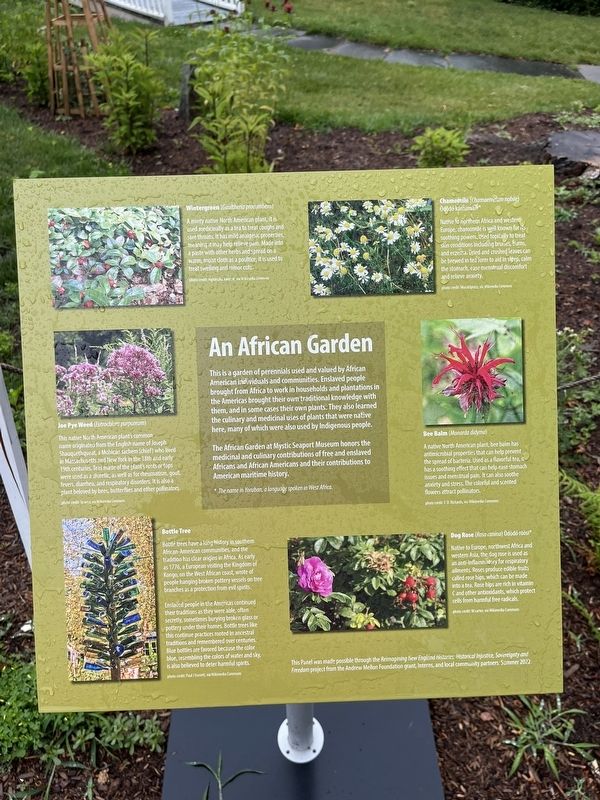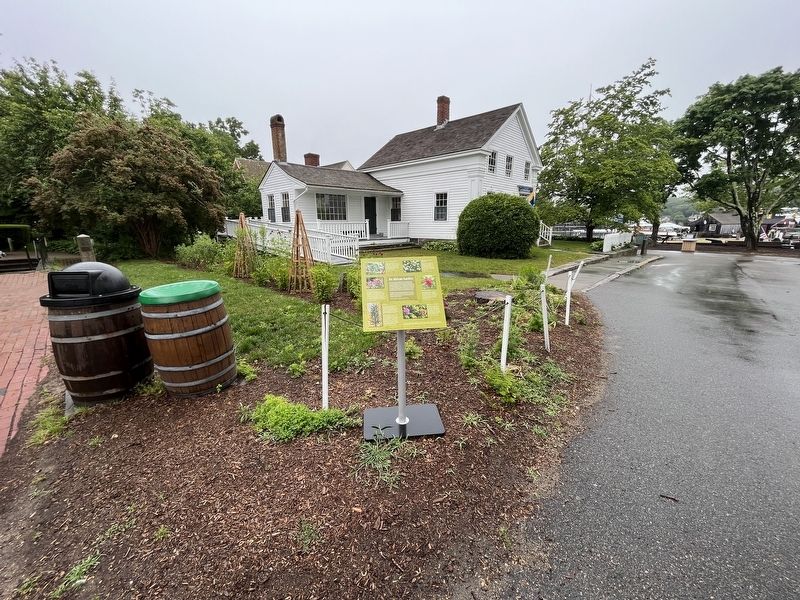Mystic in Stonington in New London County, Connecticut — The American Northeast (New England)
An African Garden
This is a garden of perennials used and valued by African American individuals and communities. Enslaved people brought from Africa to work in households and plantations in the Americas brought their own traditional knowledge with them, and in some cases their own plants. They also learned the culinary and medicinal uses of plants that were native here, many of which were also used by Indigenous people.
The African Garden at Mystic Seaport Museum honors the medicinal and culinary contributions of free and enslaved Africans and African Americans and their contributions to American maritime history.
* The name in Yoruban, a language spoken in West Africa
[Captions:]
Wintergreen (Gaultheria procumbens)
A minty native North American plant, it is used medicinally as a tea to treat coughs and sore throats. It has mild analgesic properties, meaning it may help relieve pain. Made into a paste with other herbs and spread on a warm, moist cloth as a poultice, it is used to treat swelling and minor cuts.
Chamomile (Chamaemelum nobile) Òdòdó kámúmáìlì*
Native to northern Africa and western Europe, chamomile is well known for its soothing powers. Used topically to treat skin conditions including bruises, burns, and eczema. Dried and crushed leaves can be brewed in tea form to aid in sleep, calm the stomach, ease menstrual discomfort and relieve anxiety.
Bee Balm (Monarda didyma)
A native North American plant, bee balm has antimicrobial properties that can help prevent the spread of bacteria. Used as a flavorful tea, it has a soothing effect that can help ease stomach issues and menstrual pain. It can also soothe anxiety and stress. The colorful and scented flowers attract pollinators.
Dog Rose (Rosa canina) Òdòdó róòsi*
Native to Europe, northwest Africa and western Asia, the dog rose is used as an anti-inflammatory for respiratory ailments. Roses produce edible fruits called rose hips, which can be made into a tea. Rose hips are rich in vitamin C and other antioxidants, which protect cells from harmful free radicals.
Joe Pye Weed (Eutrochium purpureum)
This native North American plant's common name originated from the English name of Joseph Shauquethqueat, a Mohican sachem (chief) who lived in Massachusetts and New York in the 18th and early 19th centuries. Teas made of the plant's roots or tops were used as a diuretic, as well as for rheumatism, gout, fevers, diarrhea, and respiratory disorders. It is also a plant beloved by bees, butterflies and other pollinators.
Bottle Tree
Bottle trees have a long history in southern African-American communities, and the tradition has clear origins in Africa. As early as 1776, a European visiting the Kingdom of Kongo, on the West African coast, wrote of people hanging broken pottery vessels on tree branches as a protection from evil spirits.
Enslaved people in the Americas continued their traditions as they were able, often secretly, sometimes burying broken glass or pottery under their homes. Bottle trees like this continue practices rooted in ancestral traditions and remembered over centuries. Blue bottles are favored because the color blue, resembling the colors of water and sky, is also believed to deter harmful spirits.
Erected 2022 by Mystic Seaport Museum, with funding through the Reimagining New England Histories: Historical Injustice, Sovereignty and Freedom project from the Andrew Mellon Foundation.
Topics. This historical marker is listed in these topic lists: African Americans • Anthropology & Archaeology • Colonial Era • Horticulture & Forestry • Native Americans • Science & Medicine. A significant historical year for this entry is 1776.
Location. 41° 21.737′ N, 71° 57.839′ W. Marker is in Stonington, Connecticut, in New London County. It is in Mystic. Marker can be reached from Greenmanville Avenue (Connecticut Route 27) south of Hinckley Street, on the left when traveling north. Touch for map. Marker is at or near this postal address: 75 Greenmanville Avenue, Mystic CT 06355, United States of America. Touch for directions.
Other nearby markers. At least 8 other markers are within walking distance of this marker. Mystic Has a Complex and Engaging History. (within shouting distance of this marker); The Parlor Garden at the Buckingham-Hall House (within shouting distance of this marker); Whale Ship Charles W. Morgan (within shouting distance of this marker); Thomas S. Greenman House (within shouting distance of this marker); Clark Greenman House (within shouting distance of this marker); An Aquinnah Wampanoag History of a Whaling Ancestor (within shouting distance of this marker); Mystic Seaport Museum First Building (within shouting distance of this marker); Bower Anchor (within shouting distance of this marker). Touch for a list and map of all markers in Stonington.
Credits. This page was last revised on June 28, 2023. It was originally submitted on June 28, 2023, by Devry Becker Jones of Washington, District of Columbia. This page has been viewed 59 times since then and 14 times this year. Photos: 1, 2. submitted on June 28, 2023, by Devry Becker Jones of Washington, District of Columbia.

